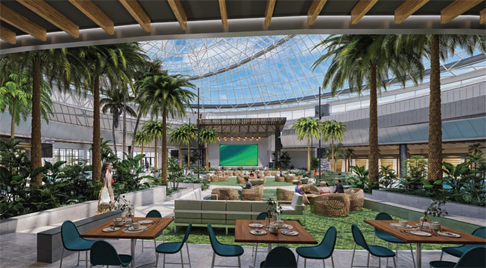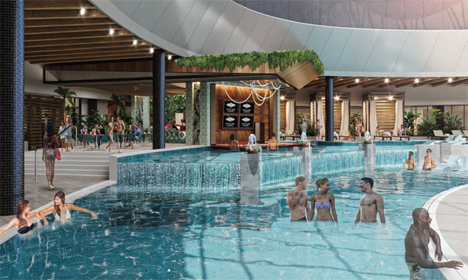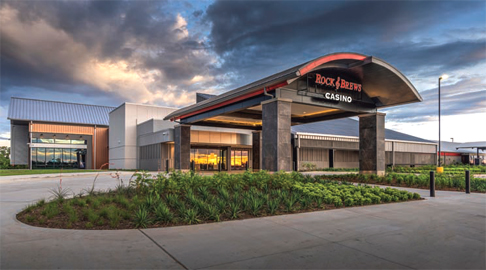
Gaming industry architecture conveys mindset over money, emotion over finance. It’s a collage of beauty, vivid colors, visual splendor and the sizzle that sells the gaming steak.
Customers, welcome to your palace.
Some of world’s best companies build that portfolio for the casino industry. While they blend economic conditions and long-term forecasts into their planning, architects must also create the warmth patrons bask in.
Architects grasp the subliminal drive that shapes customer spending, and must hit that emotional sweet spot now more than ever. The online gaming market already encourages patrons to stay home. Brick-and-mortar properties must contain more than games. They must create reasons for people to come, park, walk, dine and socialize. The customer experience is crucial to loyalty retention.
All win probabilities may be created equal, but the tactile mixture of sense, from light to sound, touch and shapes, creates the emotional difference maker in the world’s gaming halls.
Casino projects reflect this thinking.
Membership Privileges
“An entertainment experience is all about emotion—basically about having fun and enjoying yourself in an extraordinary environment,” says Dike Bacon, principal at HBG Design. “For many casino patrons, the resort is their country club. It’s their escape. It’s what they do to have fun.
“I use the analogy of a golfer. Even in tough economic times, golfers will find the money to play golf because that’s what they like to do. Even in tough times, gamblers will find the money to gamble because that’s what they like to do.”
Gaming operators jockey to find an edge. They mirror the Field of Dreams concept from the famous movie: if you build it, they will come.
“Owners and operators are expanding with larger, more targeted and exceptional property developments and improvements,” Bacon indicates. “From small-scale renovations and incremental expansions to huge multi-faceted super-regional resort-level entertainment additions. There are also exciting expansions to existing jurisdictions like Illinois and New York and huge investments in new jurisdictions like Virginia.”
Bacon hails the industry’s resilience. It faces headwinds regarding economics, the pandemic and oversaturation, but finds a way to emerge stronger.

Architects grasp the subliminal drive that shapes customer spending, and must hit that emotional sweet spot now more than ever.
“The industry seems to always be battling Chicken Little headwinds in some form or fashion, but always seems to just push through better than ever,” Bacon says. “Owners are currently molding and reshaping their expansions and renovations to accommodate changing economic conditions, but many regional gaming properties continue to ride a wave of success. In many markets, expanded facilities are creating entertainment experiences that often rival or eclipse what’s offered in Las Vegas. At HBG Design, we are working with great clients; we are busy; and we are doing great things.”
As for the environment HBG will build into, Bacon left G2E with a bullish forecast. The 2022 version was one of the most well-attended in recent years.
“G2E is often a distinct barometer of the health and breadth of the gaming industry,” he says. “If this year’s show was any indication, business conditions in the industry are very strong. The overall buzz was exceptionally positive from virtually all sectors. Early reports show trade show attendance reaching or exceeding 25,000 people, which is approaching pre-Covid numbers.”
It’s been a banner year for HBG, according to Bacon. He broke down two examples:
- One of its largest projects is the $300 million Gun Lake Casino expansion for the Gun Lake Tribe in Wayland, Michigan. The project is located just south of Grand Rapids, which is only a few hours’ drive from Chicago and Detroit. Gun Lake owners have set their sights on creating the premier entertainment destination in the Midwest, Bacon says. It’s a true super-regional resort with an expansion program designed to drive traffic from those two major metropolitan areas. The new project will consist of a 252-room hotel tower, multiple support amenities, and a new climate-controlled atrium called the Aquadome.
“As amazing as its name, Gun Lake’s new six-story, 32,000-square-foot Aquadome is a never-before-seen expansive glass-roofed, climate-controlled mixed-use landscaped pool and event center atrium environment,” Bacon indicates. “It’s a resort pool by day and a performance complex by night. The design implementation will stand out in the northern Midwest U.S. region for its uniqueness of form and year-round experience. The Aquadome will have the ability to host 2,400-person events.”
The Aquadome’s dynamic sculpted glass roof structure is modeled by the sun’s daily path across the site, and reflects the dynamic sky in all four of Michigan’s vivid seasons. The multi-layered roof composition is designed for function and efficiency. The targeted high-performance glazing and the atrium’s space frame structure combine to create the distinguishing sloped oval shape that maximizes and filters natural light from solstice to solstice.
- Four Winds Casino Resorts has been in constant evolution across its New Buffalo, Michigan and South Bend, Indiana, properties for well over 10 years, including continuously re-imagining and renovating amenities.
In 2022, HBG Design completed the new large-scale Four Winds Casino resort expansion at the South Bend, Indiana property. The expansion will be offering approachable luxury within a new 23-story, 317-key, 83-suite hotel tower and a mix of vibrant amenities, to include a spa, convention area, meeting space, a ballroom, lounge, bar & grill, an outdoor roof-top swimming pool, and terraces with spectacular views. The design will maintain the consistent brand experience guests have come to expect from all Four Winds Casino properties. The new casino expansion at South Bend opened in mid-2022.
Even at smaller gaming facilities, business is strong, Bacon asserts.
The first-ever HBG-designed Rock & Brews Casino and Restaurant owned by Kaw Gaming opened for business in Braman, Oklahoma this year.
Co-branding with recognizable names from outside the casino industry to anchor key amenities is not a new concept, but is gaining more traction with tribally owned casinos as a means to broaden market appeal and greater name recognition from an expanding customer base, Bacon says.
The 71,000-square-foot gaming project features an expertly curated interactive rock-inspired entertainment experience that only Rock & Brews—and its co-founders Paul Stanley and Gene Simmons of iconic rock band KISS—can provide. The Rock & Brews brand and venues are noted for their heavy integration of rock ‘n’ roll imagery and iconography.
Wow Is Now

The Aquadome at Gun Lake is a glass-roofed, climate-controlled indoor landscaped pool and event center atrium environment
“We help create emotions that encourage players to revisit a property by planning surprises,” says Luke Jumper, senior project manager for TBE Architects. “Our designers create ‘wow’ spaces throughout the property by paying attention to touchpoints, lighting, ambiance, and weaving elements of culture and heritage into the details. In many cases, this gives employees, owners and guests a feeling of familiar anticipation as they enter the property.
“It’s like re-reading your favorite book,” he adds. “You know the story, but each reading reveals something new. Locals casinos are especially unique because there are branding opportunities that no other company or organization is either capable or qualified to share.”
Jumper says TBE has witnessed changes over the years regarding the elements used to design “wow” spaces. The early casinos in Indian Country fashioned literal representations of basketry, nature scenes and tipis. Most modern designs have moved away from the literal representation into something more abstract.
“Consider, for instance, the new We-Ko-Pa Casino’s garden court atrium,” he says. “To the average casino or conference guest, this may simply feel like a beautiful space with some tribal references, but to members of the Fort McDowell Yavapai Nation, this space tells the story of their people, emphasizing the importance of Montezuma’s Well, life-sustaining rain, and sacred symbols that have been tastefully abstracted.
“While manner and means in which a story is told has changed, the importance of telling a story has remained constant.”
Jumper says the post-Covid market has impressed upon people the importance of physical interaction. Society as a whole has made it clear that people want to experience “life” together, no matter how advanced technology has become.
“The gaming industry is no different,” he contends. “Players are looking for quality, fresh and new experiences in the casino. Dynamic approaches to design will bring people back throughout the week to locals casinos.
“TBE eliminates ‘dark spaces’ by designing multi-purpose rooms, such as restaurants that can be converted into a private venue, a Super Bowl party or a player’s event. The point of architecture, especially hospitality, is to provide the pallet from which the operators, chefs and staff can all work together, giving them as much flexibility to create a masterpiece of service for their guests.”
Clients are asking TBE to incorporate innovations that reflect recent changes in sports legislation and the attitude toward fitness and health.

The first-ever HBG-designed Rock & Brews Casino and Restaurant owned by Kaw Gaming opened for business in Braman, Oklahoma this year
“This could look like remote betting terminals in the fitness centers, so it becomes a mini sportsbook, or offering more healthy options in the restaurants,” he says. “There’s been huge success with local farm-to-fork, confirming the need for fresh alternatives. Our clients are asking, and the more alternatives we can offer the better. This gets back to the flexibility of the building. Are we dedicating the space to just a passing fad, or do we have the ability of a multi-use of space?”
A perfect example is The Stage at Quil Ceda Creek Casino, he says. The operator has internal divider options creating flexibility for this space to work as a floor bar, a lounge bar, sports bar, and ultimately an entertainment venue with overflow space that is shared with the restaurant.
Jumper considers 2022 a retooling year for TBE. It has done significant background work for major clients that include Jacobs Entertainment in Reno and Coushatta Tribe of Louisiana in Kinder. In some cases, it has been 20 years or more since areas within these properties have received a refresh, and they now require a much more extensive overhaul.
Jumper sees a couple of innovations that can become difference-makers. One comes from phones.
“We’ve seen tribes like Sycuan that has a very sophisticated app allowing one to be at their machine and hold a place in line at a food venue,” he says. “This technology is wrought with possibilities including the ability of betting at the blackjack table while tending to your family’s needs in another part of the venue. The idea of expanding gaming throughout the property, not just on the floor, is what’s going to revolutionize the business.”
Jumper says TBE has noticed some demographics changes. More women and players 25-50 years old mark the sports-betting landscape.
He adds a word of caution.
“The industry needs to resist the attempts by sportsbook companies to proliferate the gaming kiosks,” Jumper says. “We need to encourage people who have made the infrastructure investment to keep that gaming piece for themselves. Unfortunately, states get greedy and pass legislation that waters down the market. There is a charge to protect the market, the rights, and the investment that bricks-and-mortar facilities have.”
Something for Everyone

The Stage at Quil Ceda Creek Casino
SOSH Architects offers a varied perspective of the concept.
The overall gaming-design sector is a strong one, according to John DeRichie, AIA, principal at SOSH. “SOSH Architects has seen a boom in the casino gaming and hospitality industry in 2022,” he says.
“As gaming operators continue to look for new opportunities in other locales while staying focused on capital improvement projects within existing properties, we have been fortunate enough to guide and assist our clients in creating new visions for their brand and their patrons.”
Arley Sochocky, the company’s interior design studio manager, will second that emotion. She cites subtle, yet significant factors that blend into the big picture.
“With each new design project, we are tasked with creating more than just an aesthetically pleasing space,” Sochocky indicates. “We’re creating an experience that encompasses a sense of energy, excitement and movement. The experience itself evokes human emotions that are unique to an individual’s personal filter—connecting past experiences with the present environment through the senses.”
Sochocky believes that taking emotion into account is integral to the design process when creating an experiential space. The colors, patterns and lighting used can evoke different feelings. While one guest might prefer a calming energy at a low-key VIP lounge with low lighting, warm wood tones, and lush textures, another guest might prefer the high-energy excitement of the casino floor or nightclub with color-changing lighting, LED screens, and sleek metal surfaces.
That has been put into practice in the post-pandemic world, Sochocky asserts.
“We have noticed that the consumer is re-evaluating what’s important to them,” she says. “After having limited experiences outside the home, people are now longing for truly immersive experiences with a focus on self-care in relaxation, fun, and connection. This has been reflected in our recent projects. A few years ago, we were designing hospitality spaces with ample room for a smaller number of guests.
“Now we are including communal tables, cozy bars, and lounge areas to promote conversation and connection with friends and other guests.”
Michael Mangini, the director of interior design for SOSH, believes it’s best not to chase trends or predictions.
“Great design enhances and amplifies the human experience,” he says. “What we can say with conviction is that people want to feel connected and celebrate what it is to be human. With design, we author a narrative that helps ignite a spark of emotions.
“Technology is driving innovation, and how designers and architects embrace and reinterpret it in creative ways pushes forward design,” he adds. “We see this expressed in many aspects of design and architecture, from how we design to the innovative building materials used to the user/patron experience.”
Mangini notes that technological innovation occurs so rapidly that the lives of people from one generation to the next may be radically different. What is constant, however, is the passion of the human experience.
And so, the labor of love continues in this industry.
Architects serving the gaming industry view a project as more than a job. It is a creative outlet, a challenge to their exceptional skills. They want to provide something that is more than structurally sound. They want it to structurally sing.





